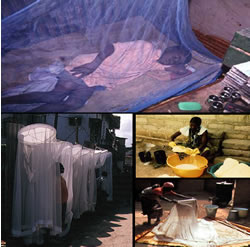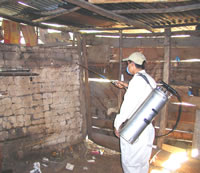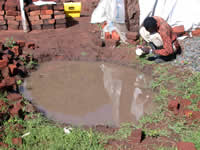|
|
|||||
|
|
On
This Page: General InformationVector control aims to decrease contacts between humans and vectors of human disease. Control of mosquitoes may prevent malaria as well as several other mosquito-borne diseases. Elimination of malaria in an area does not require the elimination of all Anopheles mosquitoes capable of transmitting the disease. In North America and Europe, Anopheles mosquitoes capable of transmitting malaria are still present, but the parasite has been eliminated. Socio-economic improvements (e.g., houses with screened windows, air conditioning) combined with vector reduction efforts and effective treatment have led to the elimination of malaria without the complete elimination of the vectors. Vector control for the prevention of malaria includes: Insecticide-Treated Bed NetsInsecticide-treated bed nets (ITNs) are a form of personal protection that has repeatedly been shown to reduce severe disease and mortality due to malaria in endemic regions. In community-wide trials in several African settings, ITNs have been shown to reduce all-cause mortality by about 20%. 
Insecticide-treated bed nets (ITNs) are now a major intervention for malaria control. Untreated bed nets form a protective barrier around persons using them. However, mosquitoes can feed on people through the nets, and nets with even a few small holes provide little, if any, protection. The application of a residual insecticide greatly enhances the protective efficacy of bed nets. The insecticides used for treatment kill mosquitoes and other insects. The insecticides also have repellent properties that reduce the number of mosquitoes that enter the house and attempt to feed. In addition, if high community coverage is achieved, the numbers and longevity of mosquitoes will be reduced. When this happens, all members of the community are protected, regardless of bed net ownership. To achieve such effects, high community coverage is required, as for indoor residual spray. There are several types of nets available. Nets may vary by size, material, and/or treatment. Most nets are made of polyester but nets are also available in cotton, polyethylene, or polypropylene. Currently, only pyrethroid insecticides are approved for use on ITNs. These insecticides have very low mammalian toxicity but are highly toxic to insects and have a rapid knock-down effect, even at very low doses. Pyrethroids have a high residual effect: they do not rapidly break down unless washed or exposed to sunlight. Previously, nets had to be retreated at intervals of 6-12 months, more frequently if the nets were washed. Nets were retreated by simply dipping them in a mixture of water and insecticide and allowing them to dry in a shady place. The need for frequent retreatment was a major barrier to full implementation of ITNs in endemic countries. The additional cost of the insecticide and the lack of understanding of its importance resulted in very low retreatment rates in most African countries. Long-Lasting Insecticide-treated Nets (LLINs)More recently, several companies have developed long-lasting insecticide-treated nets (LLINs) that retain lethal concentrations of insecticide for at least 3 years. The WHO Pesticide Evaluation Scheme has recommended five of these LLINs for use in the prevention of malaria. CDC is currently testing these and other LLINs in Atlanta and Kenya. The WHO Pesticide Evaluation Scheme recommends these LLINs:
Travelers to malaria-risk areas may also use ITNs as one of several precautions against malaria. For information on ordering insecticide-treated bed nets:
Indoor Residual SprayingMany malaria vectors are endophilic, resting inside houses after taking a blood meal. These mosquitoes are particularly susceptible to control through indoor residual spraying (IRS). As its name implies, IRS involves coating the walls and other surfaces of a house with a residual insecticide. For several months, the insecticide will kill mosquitoes and other insects that come in contact with these surfaces. IRS does not directly prevent people from being bitten by mosquitoes. Rather, it usually kills mosquitoes after they have fed, if they come to rest on the sprayed surface. IRS thus prevents transmission of infection to other persons. To be effective, IRS must be applied to a very high proportion of households in an area (usually >70%).
IRS with DDT and dieldrin was the primary malaria control method used during the Global Malaria Eradication Campaign (1955-1969). The campaign did not achieve its stated objective but it did eliminate malaria from several areas and sharply reduced the burden of malaria disease in others. Resistance to DDT and dieldrin and concern over their environmental impact led to the introduction of other, more expensive insecticides. As the eradication campaign wore on, the responsibility for maintaining it was shifted to endemic countries that were not able to shoulder the financial burden. The campaign collapsed and in many areas, malaria soon returned to pre-campaign levels. As a result of the cost of IRS, the negative publicity due to the failure of the Malaria Eradication Campaign, and environmental concerns about residual insecticides, IRS programs were largely disbanded other than in a few countries with resources to continue them. However, the recent success of IRS in reducing malaria cases in South Africa by more than 80% has revived interest in this malaria prevention tool. It has also reignited the debate over whether or not DDT should have a place in malaria control. With support from the Global Fund to fight AIDS, Tuberculosis and Malaria as well as the President’s Malaria Initiative, several countries have initiated IRS programs—many using DDT in their arsenal of insecticides—for the control of malaria. Insecticide ResistanceInsecticide-based control measures (e.g. indoor spraying with insecticides, ITNs) are the principal way to kill mosquitoes that bite indoors. However, after prolonged exposure to an insecticide over several generations, mosquitoes, like other insects, may develop resistance, a capacity to survive contact with an insecticide. Since mosquitoes can have many generations per year, high levels of resistance can arise very quickly. Resistance of mosquitoes to some insecticides has been documented with just within a few years after the insecticides were introduced. There are over 125 mosquito species with documented resistance to one or more insecticides. The development of resistance to insecticides used for indoor residual spraying was a major impediment during the Global Malaria Eradication Campaign. Judicious use of insecticides for mosquito control can limit the development and spread of resistance. However, use of insecticides in agriculture has often been implicated as contributing to resistance in mosquito populations. It is possible to detect developing resistance in mosquitoes and control programs are well advised to conduct surveillance for this potential problem. Related Sources:
Source Reduction (Larval Control)Source reduction is the method of choice for mosquito control when the mosquito species targeted are concentrated in a small number of discrete habitats. The larval habitats may be destroyed by filling depressions that collect water, by draining swamps, or by ditching marshy areas to remove standing water. Container-breeding mosquitoes are particularly susceptible to source reduction as people can be educated to remove or cover standing water in cans, cups, and rain barrels around houses. Mosquitoes that breed in irrigation water can be controlled through careful water management. For some mosquito species, habitat elimination is not possible. For these species, chemical insecticides can be applied directly to the larval habitats. Other methods, which are less disruptive to the environment, are usually preferred:
Source reduction is an ideal approach to mosquito control. Mosquito larvae are concentrated in defined areas, and source reduction eliminates mosquitoes before they reach the stage that is responsible for disease transmission. Unfortunately, source reduction is not always feasible. The larval habitats may be small, widely dispersed, and transient. Anopheles gambiae, one of the primary vectors of malaria in Africa, breeds in numerous small pools of water that form due to rainfall. The larvae develop within a few days, escaping their aquatic environment before it dries out. It is difficult, if not impossible, to predict when and where the breeding sites will form, and to find and treat them before the adults emerge. Therefore, larval mosquito control for the prevention of malaria in Africa has not been attempted on a large scale. Other Vector Control Methods
Fogging or area spraying is primarily reserved for emergency situations: halting epidemics or rapidly reducing adult mosquito populations when they have become severe pests. Fogging and area sprays must be properly timed to coincide with the time of peak adult activity, because resting mosquitoes are often found in areas that are difficult for the insecticide to reach (e.g., under leaves, in small crevices). Personal protection measures include the use of window screens, ITNs (see above), and repellents (such as DEET) and wearing light-colored clothes, long pants and long-sleeved shirts. Well-constructed houses with window screens are effective for preventing biting by mosquitoes that bite indoors and likely contributed much to the elimination of malaria from the United States and Europe. Sterile male release has been successfully applied in several small-scale areas. However, the need for large numbers of mosquitoes for release makes this approach impractical for most areas. Genetic modification of malaria vectors aims to develop mosquitoes that are refractory to the parasite. This approach is still several years from application in field settings. Related Sources of Information
* Links to non-Federal organizations found at this site are provided solely as a service to our users. These links do not constitute an endorsement of these organizations or their programs by CDC or the Federal Government, and none should be inferred. CDC is not responsible for the content of the individual organization Web pages found at these links. Page last modified : January 10, 2008 Content source: Division of Parasitic Diseases National Center for Zoonotic, Vector-Borne, and Enteric Diseases (ZVED)
|
|
|||||||||||||||||||||||||||
| Home | Policies and Regulations | Disclaimer | e-Government | FOIA | Contact Us | ||||||
|





